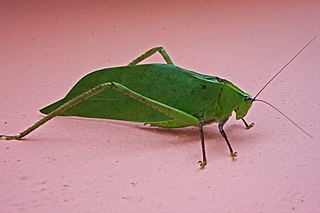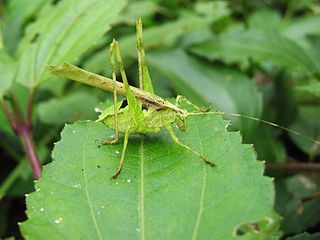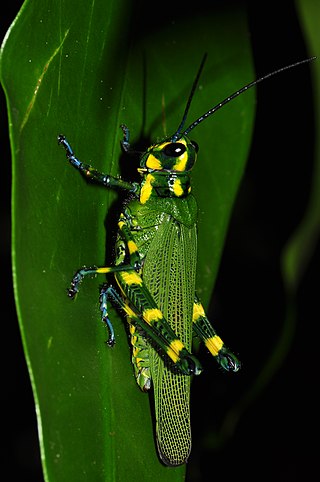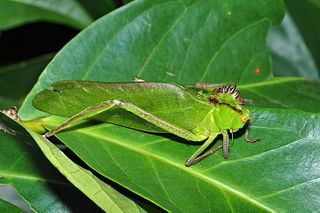Belocephalus is a genus of short-winged coneheads in the family Tettigoniidae. Coneheads are a type of bush crickets or katydids. There are about eight described species in Belocephalus.

Stilpnochlora couloniana is a species of phaneropterine katydid in the family Tettigoniidae, native to southeastern United States, the Bahamas and Cuba. It is known as the giant katydid and it is the largest katydid in the United States, with an average length of 6.6 cm (2.6 in) in adult males and 7.8 cm (3.1 in) in adult females. Individuals from Cuba tend to grow 5–10% larger than those from the United States. They are sometimes kept as pets.

Syrbula montezuma, known generally as the Montezuma's grasshopper or slant-faced grasshopper, is a species of slant-faced grasshopper in the family Acrididae. It is found in Central America and North America.

Steiroxys strepens, known generally as the noisy shieldback or shield-backed katydid, is a species of shield-backed katydid in the family Tettigoniidae. It is found in North America.

Gryllidea is an infraorder that includes crickets and similar insects in the order Orthoptera. There are two superfamilies, and more than 6,000 described species in Gryllidea.

Insara, commonly known as western bush katydids, is a genus of katydids in the family Tettigoniidae.

Capnobotes is a North-American genus of shield-backed katydids in the family Tettigoniidae. There are about 9 described species in Capnobotes.

Trimerotropini is a tribe of band-winged grasshoppers in the family Acrididae. There are at least 70 described species in Trimerotropini: found in the western Americas.
Neobarrettia victoriae, the lesser arid-land katydid, is a species of spiny predatory katydid in the family Tettigoniidae. It is found in Central America and North America.

Steiroxys is a genus of shield-backed katydids in the family Tettigoniidae.

Syrbula is a genus of slant-faced grasshoppers in the family Acrididae. There are at least three described species in Syrbula.

Psinidia is a genus of band-winged grasshoppers in the family Acrididae. There are at least three described species in Psinidia.

Amblycorypha is a North American genus of round-headed katydids in the family Tettigoniidae. There are about 14 described species in Amblycorypha.

Xanthippus is a genus of band-winged grasshoppers in the family Acrididae. There are about six described species in Xanthippus.
Obolopteryx emarginata, the spoon-tail short-wing katydid is the type species of phaneropterine katydids of its genus. It is found in North America.

Podoscirtinae is a subfamily of crickets in the family Gryllidae.
Pterophyllini is a tribe of true katydids in the family Tettigoniidae. There are about 16 genera and more than 40 described species in Pterophyllini.

Chromacris is a genus of lubber grasshoppers in the family Romaleidae. The nine described species in Chromacris are found in Mexico, Central America, or South America. They often have bright aposematic colors and they are presumed to be toxic.

Moncheca is a genus of relatively large, colorful conehead katydids in the tribe Copiphorini, native to the Neotropics.

Steirodon is a genus of large phaneropterine katydids in the family Tettigoniidae, native to tropical and subtropical forests in South America, Central America and Mexico.
















